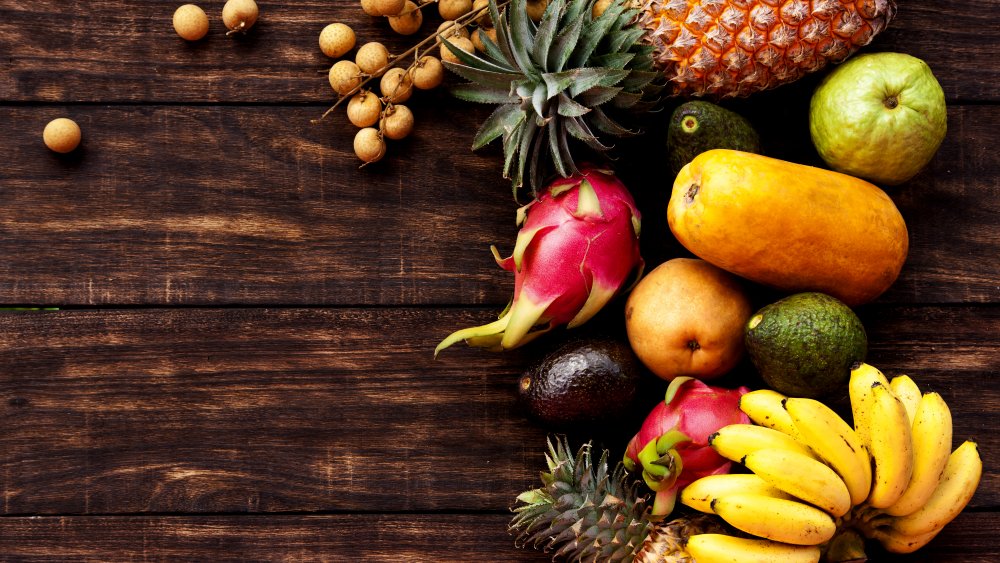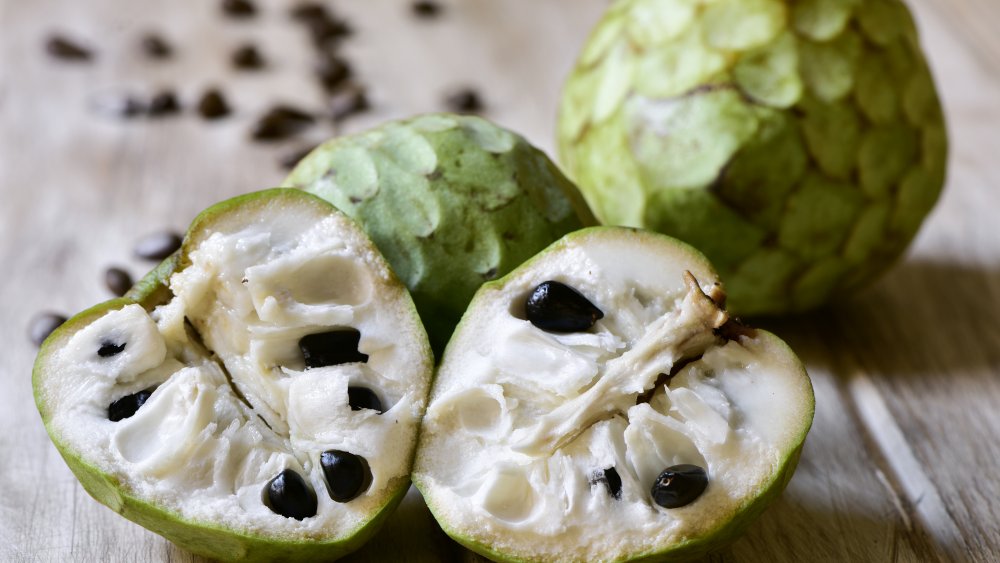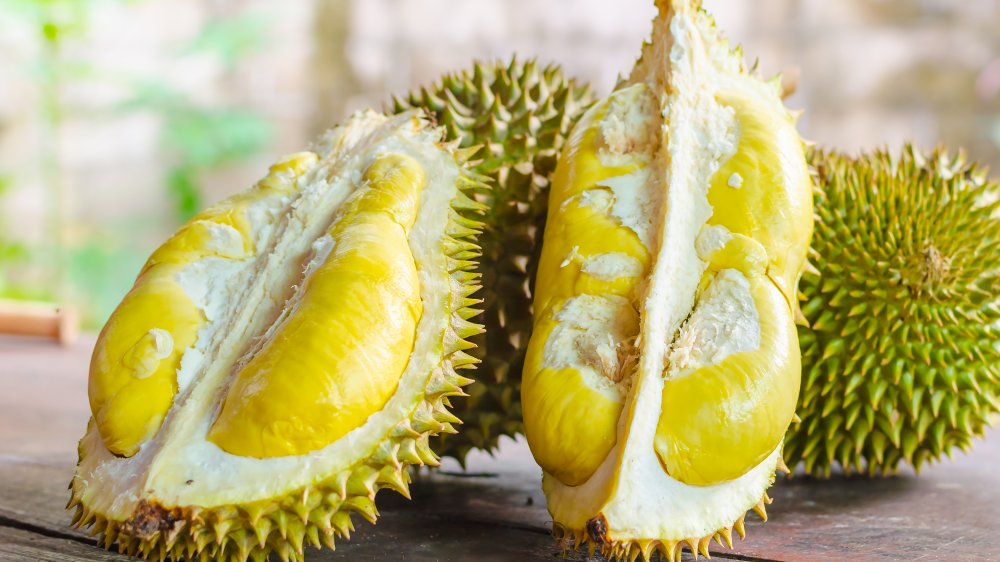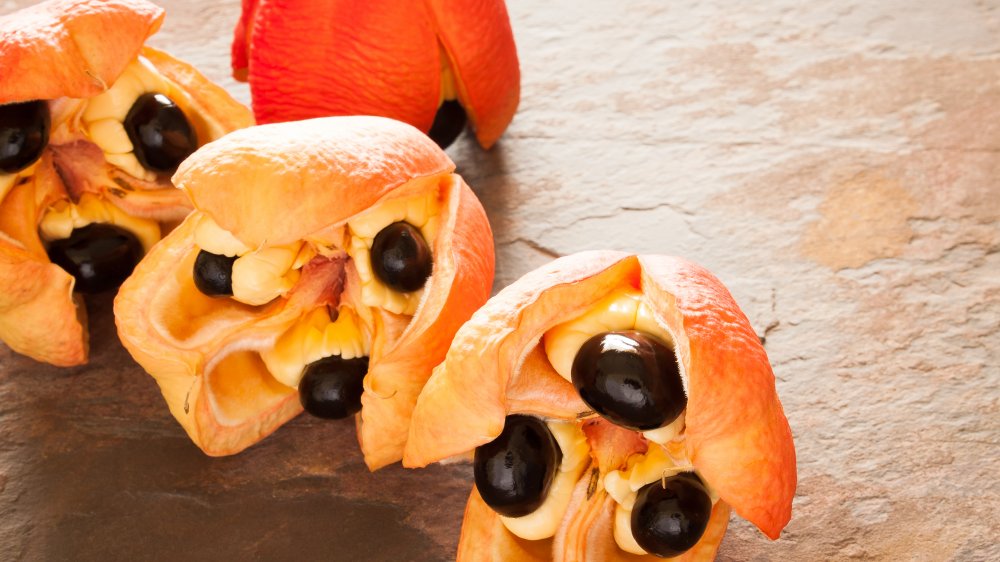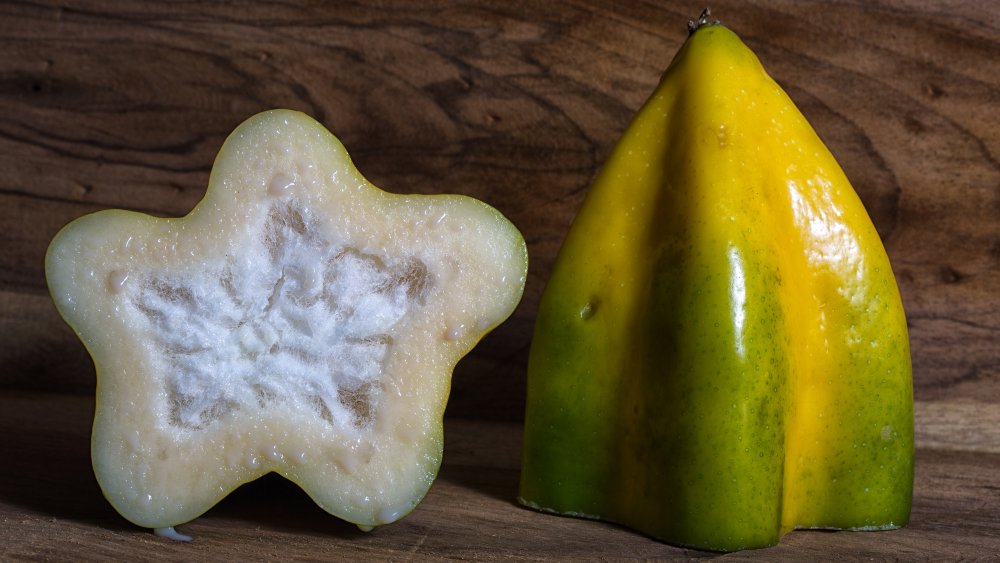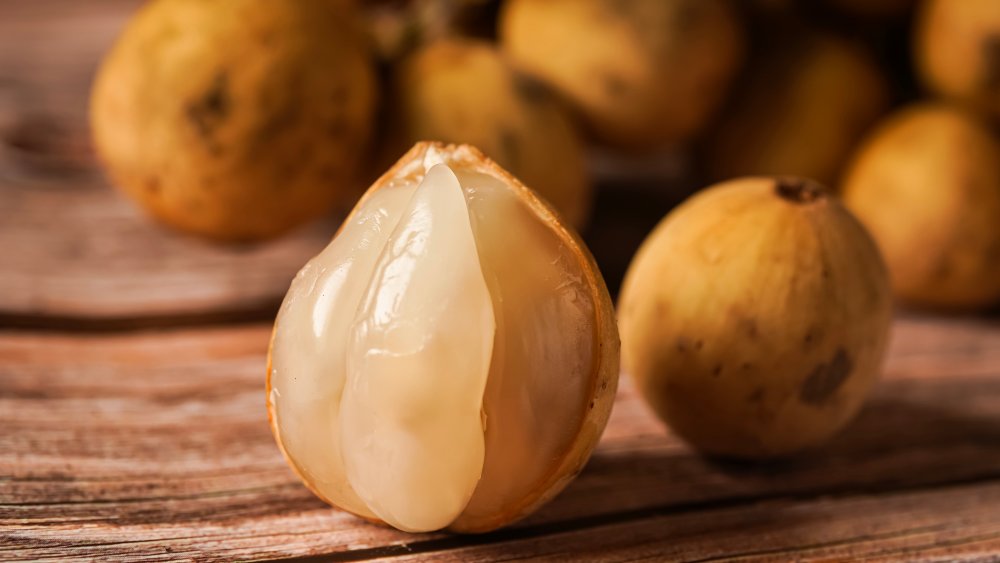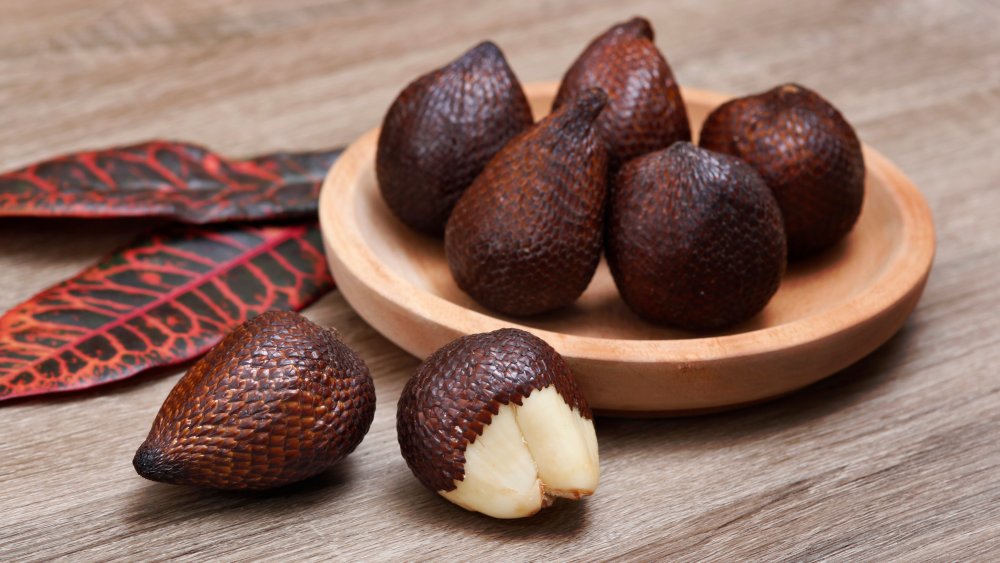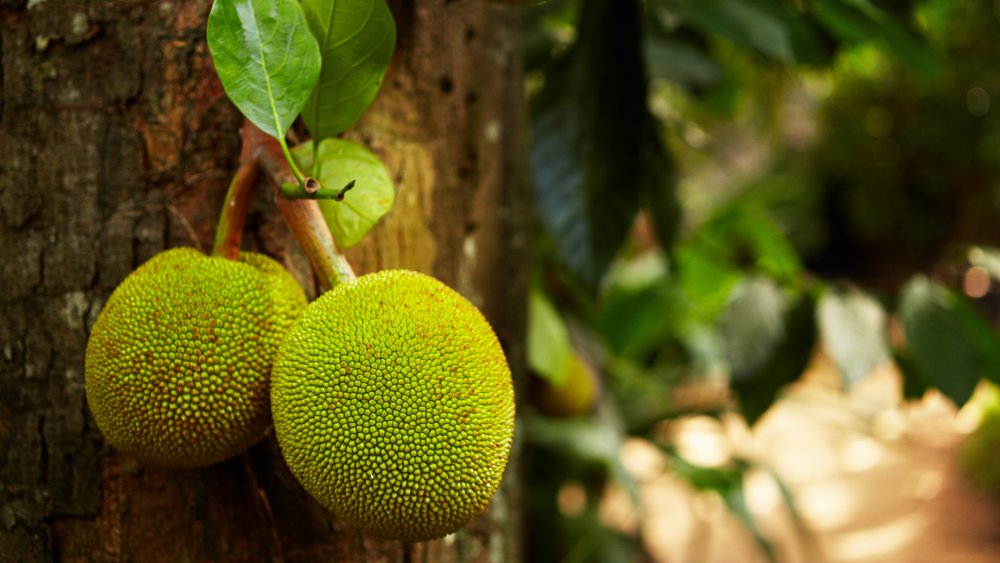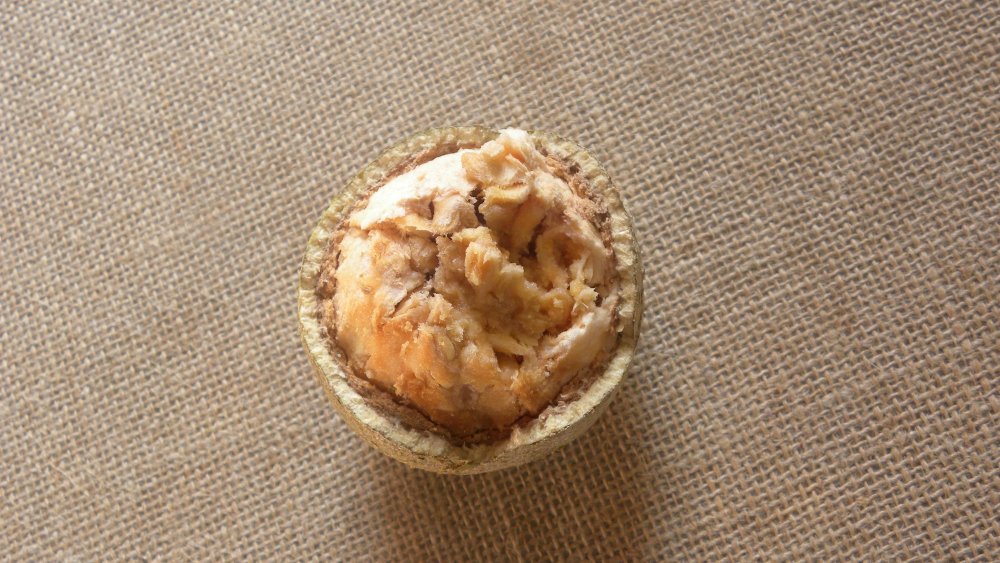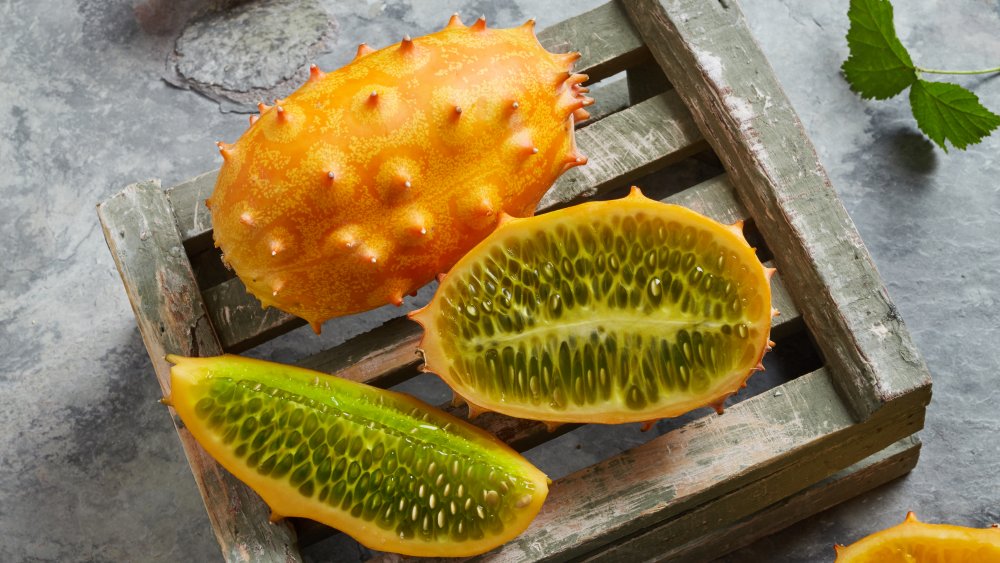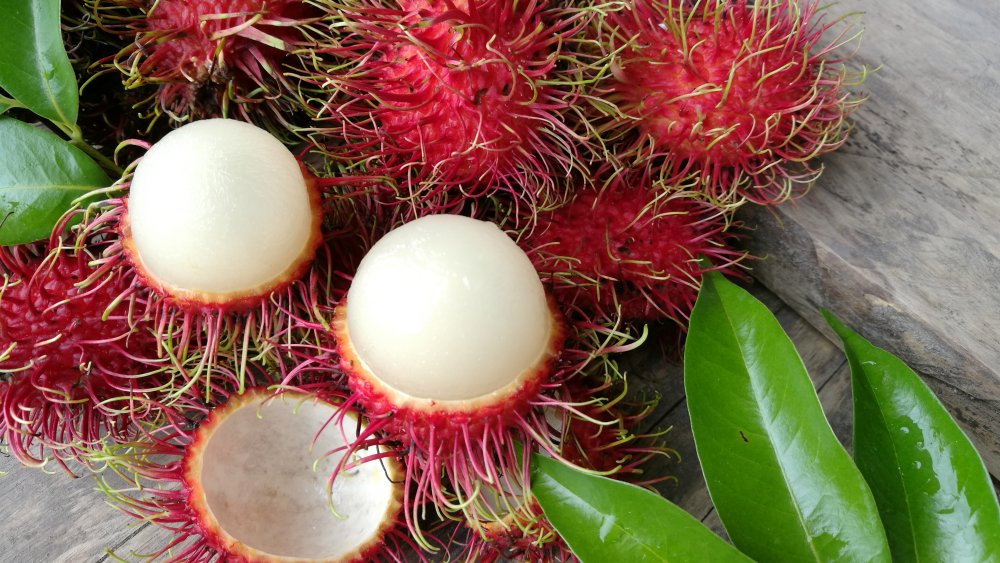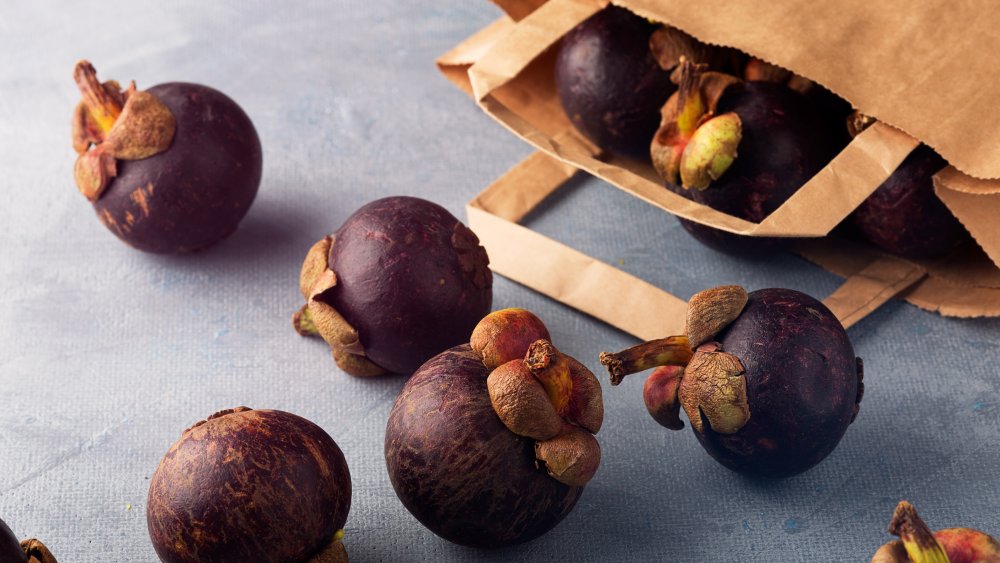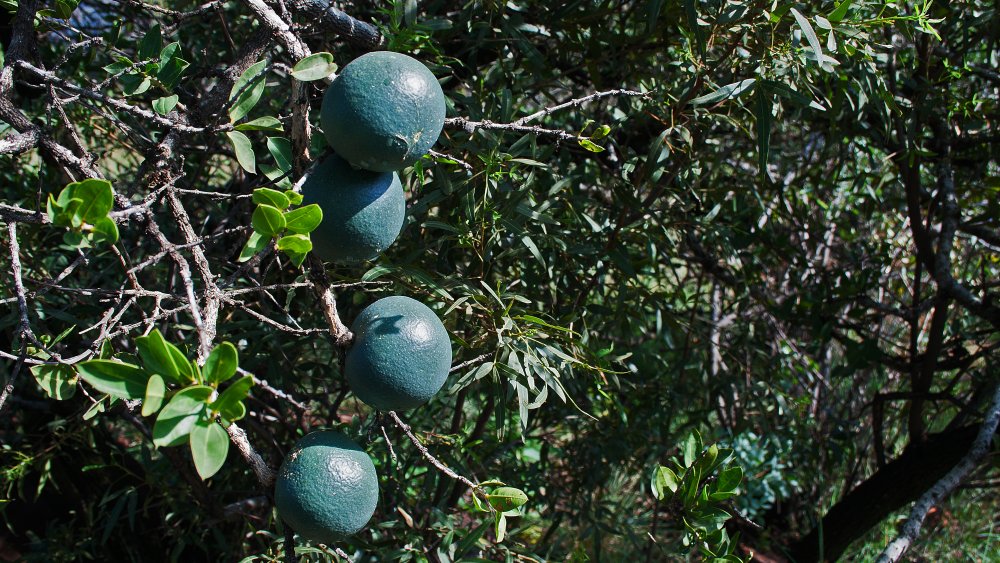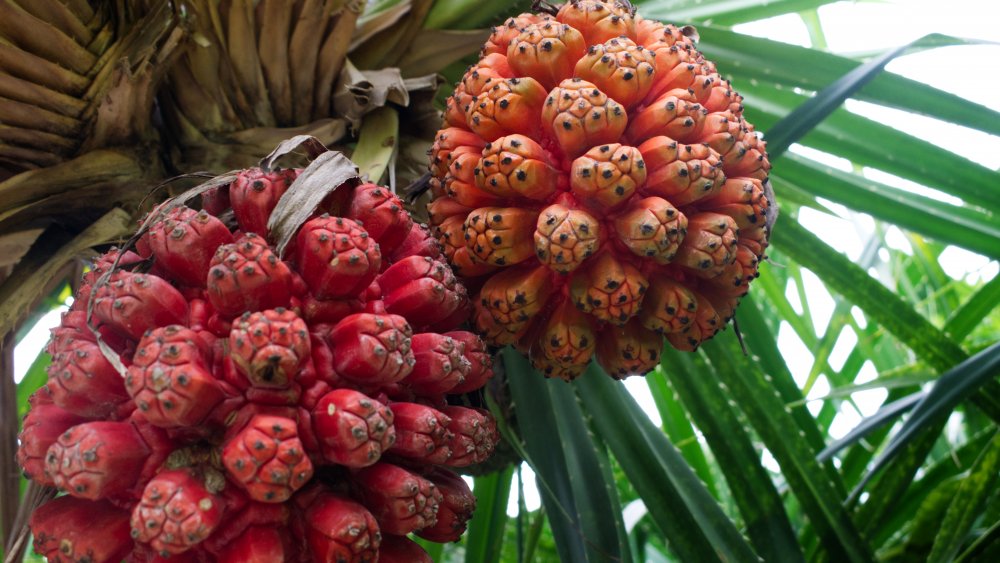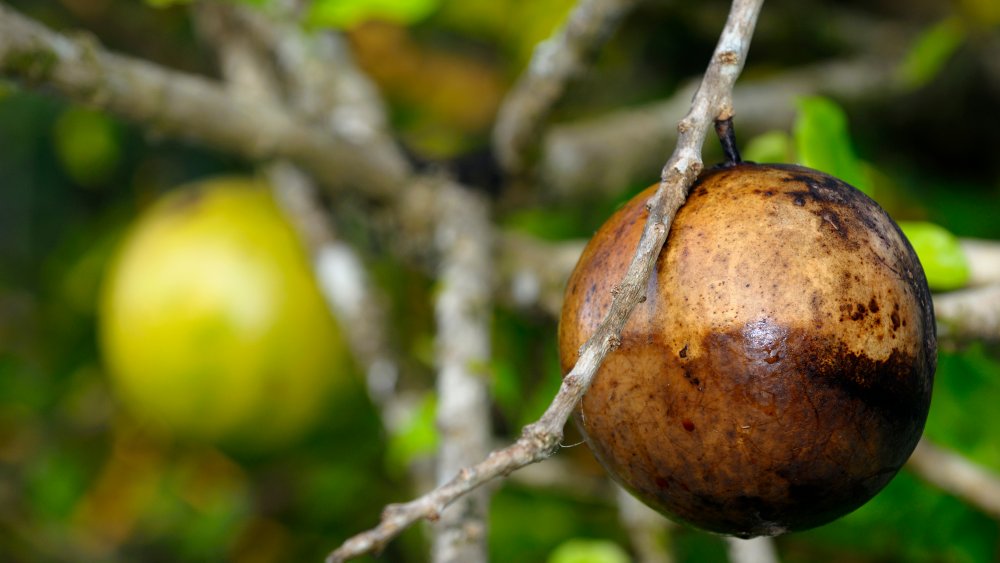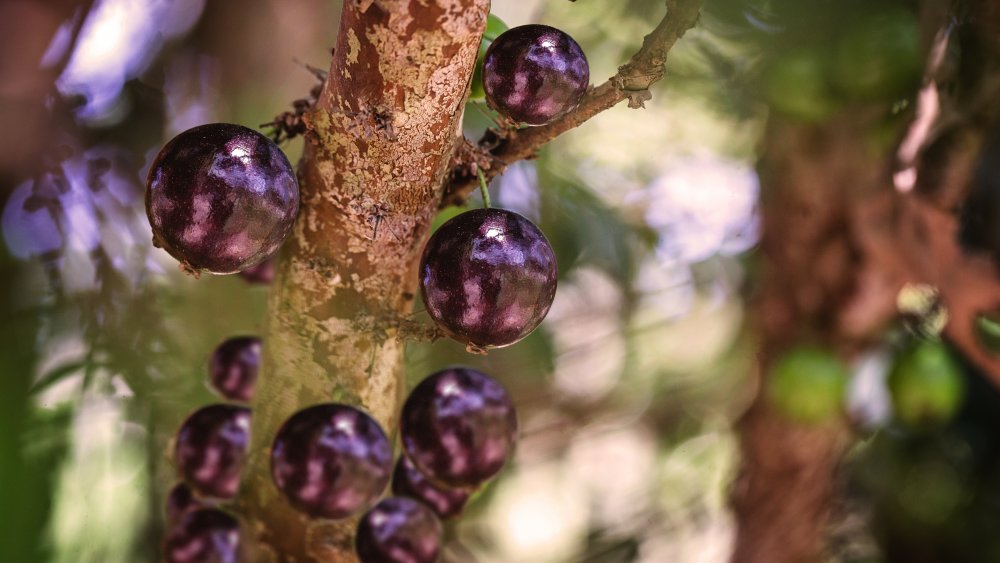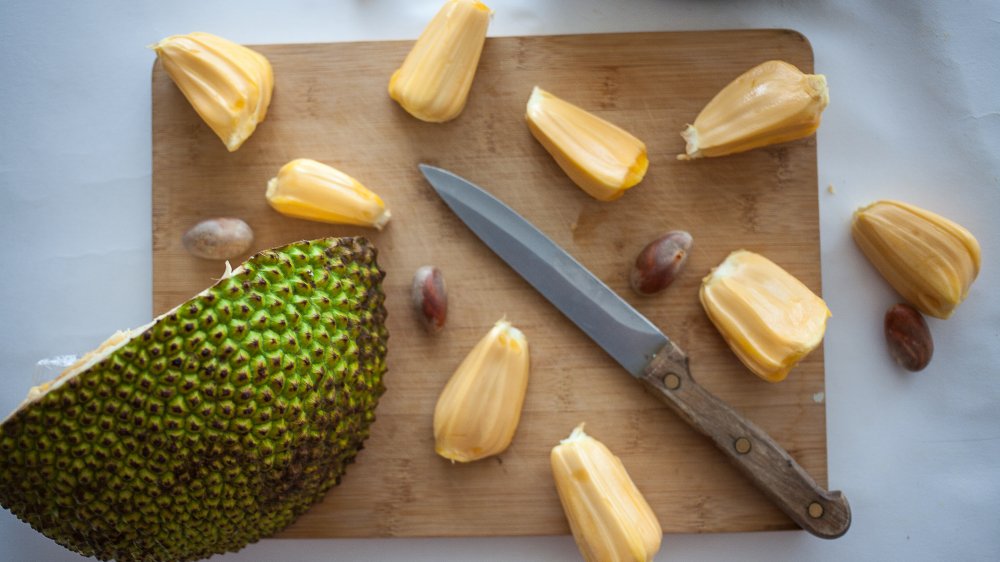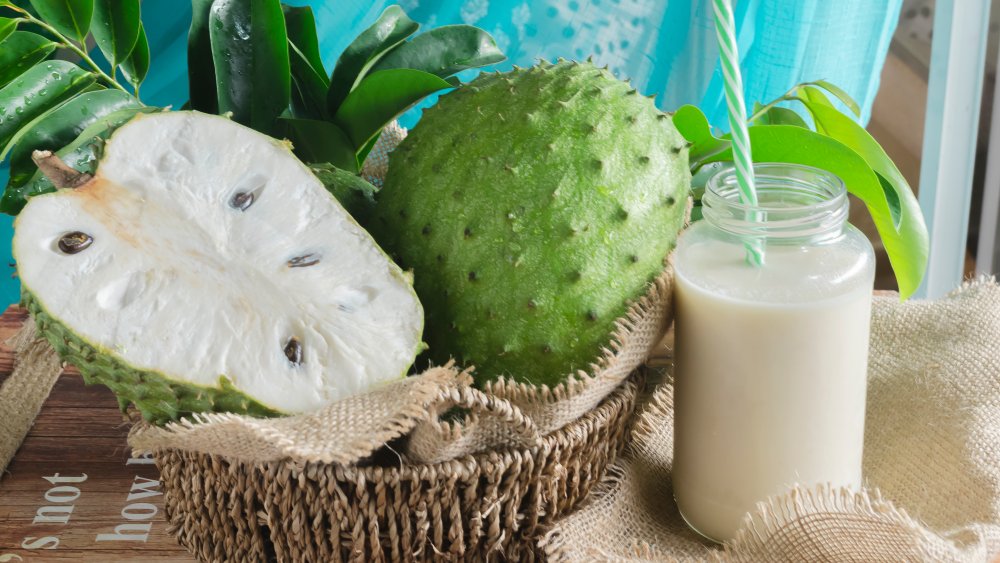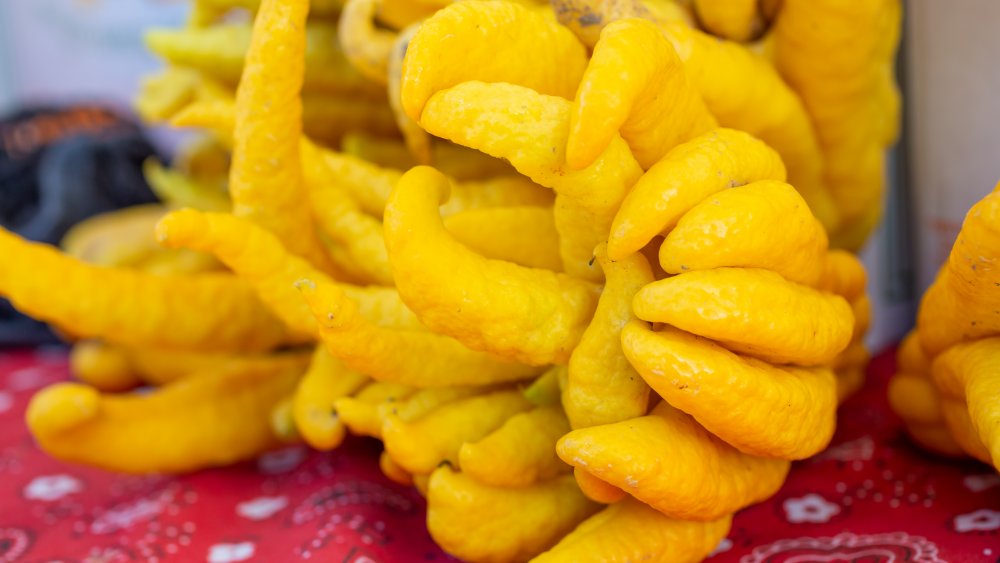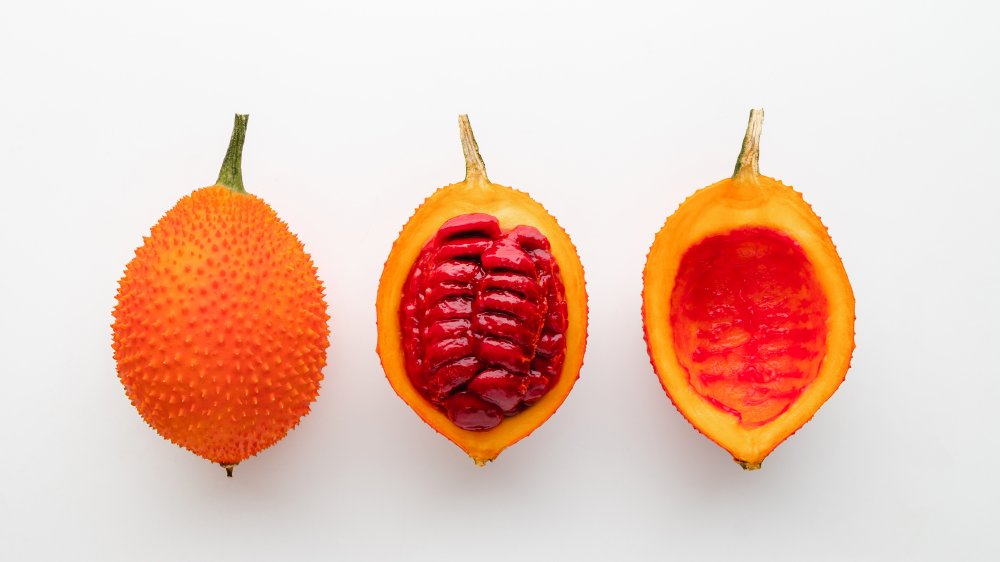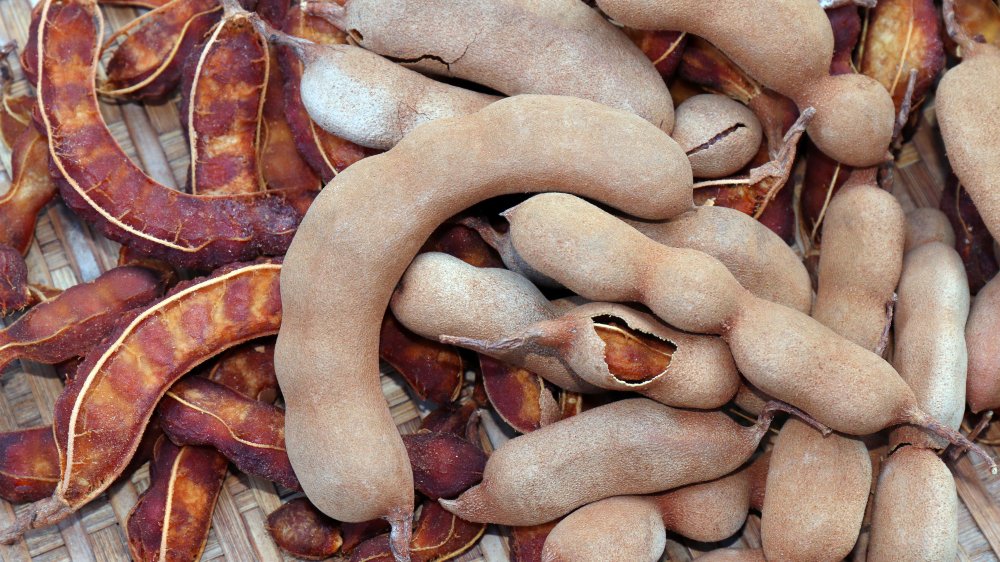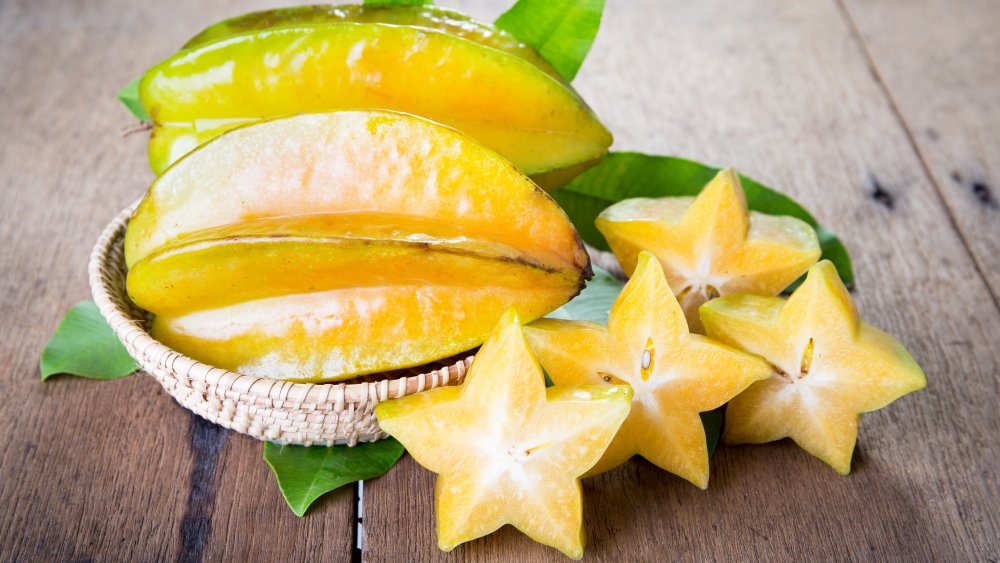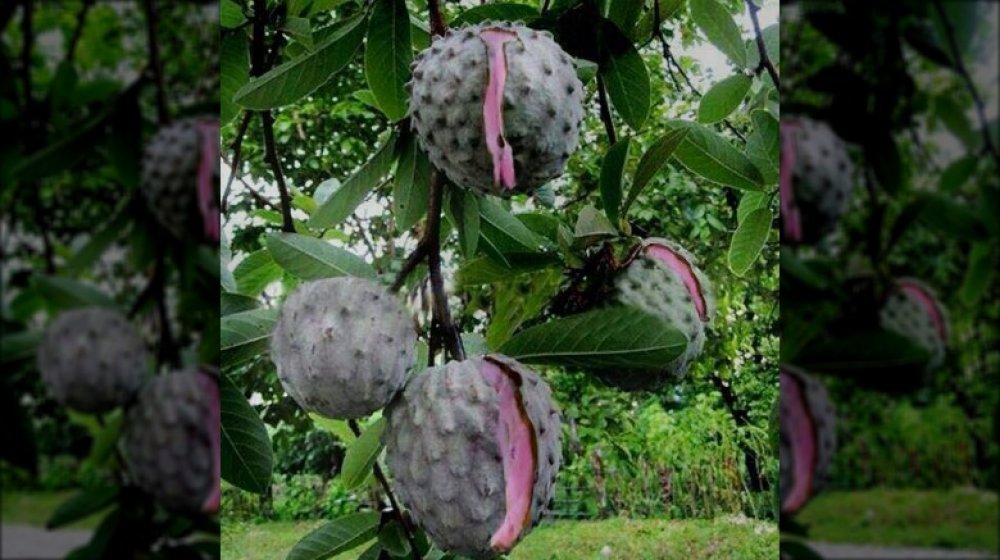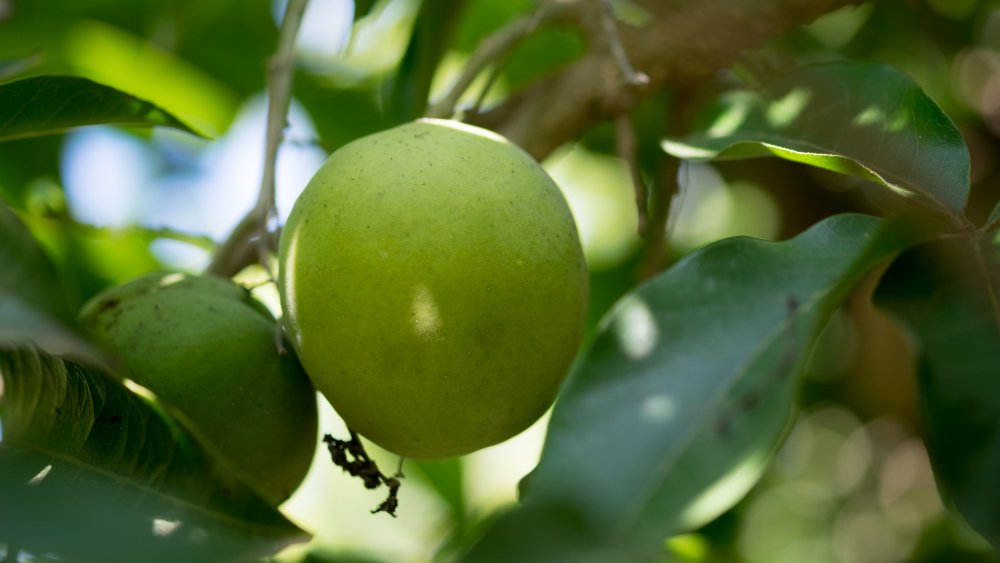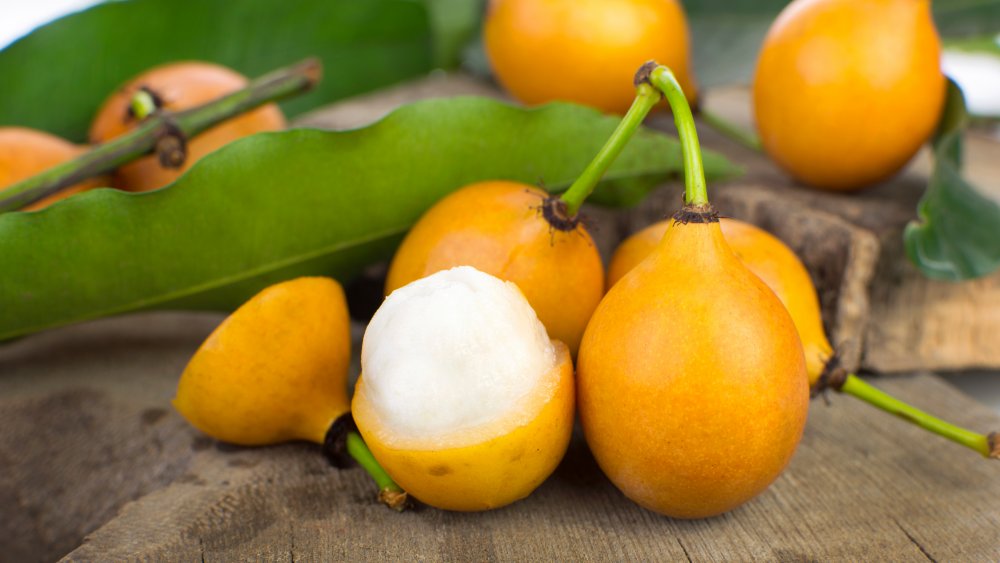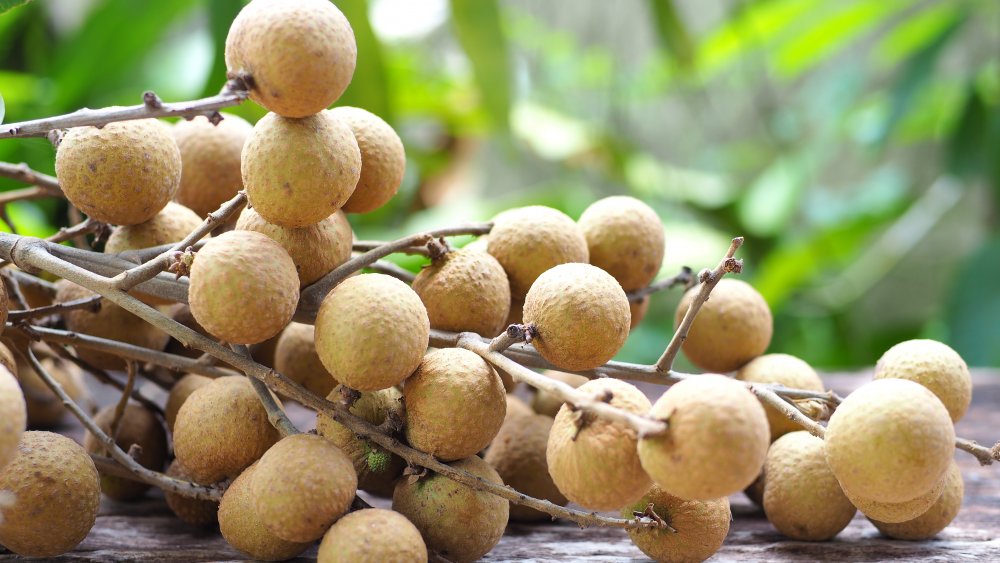Unusual Tropical Fruits You Need To Try Before You Die
Getting your recommended servings of fruits and vegetables can seem like a challenge, but for many of us, it's the fruits that are the saving grace. And among those fruits, tropical fruits are undeniably delicious. Who doesn't love snacking on a few fingers of pineapple or enjoying half of a fresh grapefruit for breakfast? They're amazing in juice form, too — who says "No, thanks!" to some pomegranate juice or coconut water?
Even across the warmer parts of the U.S., we're sort of limited by the number of tropical fruits we see on a normal trip to the grocery store. And that's a downright shame, because there's an almost shocking number of unusual tropical fruits that you've probably never even heard of, much less had the opportunity to try. But you absolutely should, and we're going to tell you what you should keep an eye out for. Whether you're browsing a local import shop or specialty grocery store or — better yet — planning a trip abroad, these are the unusual tropical fruits you need to try before you die.
Cherimoya
The cherimoya doesn't look like much, but that just goes to show that looks can be deceiving. Inside that weird, scaly exterior — a skin that looks more like a dragon's egg than a tropical fruit — is a super creamy, super sweet-tasting, almost custardy flesh. "Custardy" is actually pretty accurate — it's often served just chilled then sliced open, and in some places, it's called the custard apple.
As if the prospect of trying a bit of delicious, all-natural, tropical custard isn't enough, you should also know they're loaded with all kinds of other goodness, like antioxidants, mood-boosting vitamins, and nutrients that help regulate blood pressure and digestion. All in a tasty dessert!
Best of all, you might not even have to leave the country for this one. If you're on the West Coast, the LA Times says you may have seen these occasionally popping up in a grocery store or on restaurant menus. They're thought to have originated in South America, and they're a little weird in that they're a tropical fruit that thrives at high altitudes (via Healthline) — so at the very least, keep an eye out when you take your dream holiday to Peru.
Durian
Durian: the most polarizing fruit on the planet. That's safe to say, right?
Here's the thing — while the Smithsonian says that scientists have actually discovered what chemicals the fruit contains that give it that distinctive smell (which they say Food writer Richard Sterling describes as "turpentine and onions, garnished with a gym sock"), it's still been incredibly popular for ages. It's even rumored to be an aphrodisiac!
But that's not why you should try it — you should try it because some people love the taste of it. The 17th century missionary Jacques de Bourges claimed (via Mental Floss) it "exceeds in delicacy of taste of all our best European fruits, and none of ours can approach it," while at the same time, The Oxford Companion to Food described it more with words like "sewage" and "stale vomit." Others claim that it's one of those things that you come to like, but let's be honest: you're intrigued, right? And that's why you need to try it — next time you find yourself in South Asia, or when you spot it in any of the places it's actually allowed.
Ackee
Ackee is native to West Africa, but you don't have to go that far to try it. In fact, you just have to go a stone's throw from the continental U.S. to visit the place that does it best: Jamaica.
And this is one fruit that you definitely need to try after someone knowledgeable has made it for you. The pulp of the ackee fruit, says The New Yorker, contains a poison that disappears only when the fruit is completely ripe. It's so dangerous that the FDA banned it outright for a long time, and even now, the only ackee you can get in the States is canned or frozen. But if you want the real thing, head south and try Jamaica's national dish.
You can get ackee and saltfish across the country, and while there are a number of variations, the idea is the same no matter where you're ordering. It's the very embodiment of an entire culture, and that's why you need to try it — just don't pick one off a tree.
Babaco
Just for a moment, imagine drinking a glass of champagne or sparkling wine. You know that bubbly, effervescent quality, the one that tickles your nose and tongue? That's actually what you'll taste if you try a babaco, and it's so well-known for that fizz that it's also called the champagne fruit (via Specialty Produce). Pretty cool, right?
Sadly, this one might be tough to find. The Slow Food Foundation for Biodiversity says that even though it's a versatile fruit that's brilliant in drinks, jams, and sweets, it's susceptible to pests and disease. That means a lot of farmers in Babcao's native region — high in the Andes and in Ecuador — have given up farming it. Lack of transportation in the Amazon forests where it grows best is also a problem, but if you happen to be in the area during Corpus Christi festivals, be sure to seek out the pastries traditionally made with this native fruit.
Lanzones
Lanzones are a tropical fruit native to the Philippines, and they have a sweet-and-sour taste that, well, if you love Sour Patch Kids, you'll love these.
They're not just a native fruit, either — they're so important that they've made it into Filipino folklore. According to Choose Philippines, it's said that lanzones were originally poisonous. Drought and famine came, and even as the people starved, they were still afraid to eat the fruit. Until, that is, a dancing lady came to town. She danced and sang, and ate the fruit — and didn't die. The once-forbidden fruit saved the town, and entered into lore and legend. Expert World Travel notes that there's still an annual lanzones festival held every October on the island of Camiguin, and if you truly want to experience a country and its people, you'll have to experience their food.
Salak
Now, let's hop over to Indonesia. If you happen to be lucky enough to vacation in Bali, you'll need to sample one of the favorite snacks of the local people. It's called salak — or snakefruit — and don't let that other name discourage you. While it's a frequent ingredient in things like spreads or jams, it's often just eaten raw, too.
It'll take some work — you'll have to crack it open and peel off the skin that surrounds the center — but once you get the hang of it, you'll find yourself enjoying a spongy bite of fruit that's highly acidic, very citrusy, and dry in the same way a fine wine can be dry. According to the Smithsonian, the spiky salak bushes might look like something out of a bygone, prehistoric era, but competitions between the islands — each claiming they grow the best salak — are very much the stuff of the 21st century. Different varieties offer slightly different experiences, and if you love it, you can also pick up a bottle of salak wine!
Breadfruit
If you're heading off on that Hawaiian vacation you've been dreaming of for years, here's something to add to your must-see, must-try list: breadfruit. It's been a longtime staple on menus and in Hawaiian diets, and it's a weird thing. According to ethnobotanist Diane Ragone (via NPR), it's odd in that you can eat it while it's unripe (and tastes a bit like an artichoke) or when it's ripe (when it's sort of like a potato). Once it gets a little softer, then it turns into something you'd have for dessert.
No matter how it's prepared, it's high in protein and nutrients — and that means it's perfect for spreading to tropical areas where food is scarce. Trees are productive for generations, and bear up to 250 fruits each and every year. So try one — an increase in demand can only be a good thing, and who knows: when you head off island-hopping across the Pacific, you might just come across some new varieties to try.
Wood apple
The term "wood apple" definitely sounds like it's slang for something else, but it's not — it's actually the name of the fruit that Specialty Produce calls Sri Lanka's national treasure. Imagine a coconut, and you're part of the way there. Traditionally given as offerings to Lord Ganesh, wood apples have become much more popular as a foodstuff since the 1950s, when processing technologies advanced to make them not nearly so difficult to eat.
It's not often you'll get the chance to sample a fruit so ingrained in an area's history, culture, and religion. Mentions of the wood apple go back to Buddhist writings from the 600s, and since at least the 900s, it's been valued for medicinal properties. The Times of India says it's long been used to aid digestion and as a treatment for liver and kidney problems. Recent studies have confirmed it has natural, antimicrobial properties, so there's something to this age-old treasure!
Kiwano
Are you a sci-fi fan? More specifically, are you a Trekkie? That's reason enough to give a kiwano a try, or, better yet, serve it at your next sci-fi-inspired party.
The kiwano looks weird — so weird, in fact, that it doubled as a "Golana melon" on an episode of Star Trek: Deep Space Nine (via Atlas Obscura). Fortunately for anyone looking to add an incredibly weird fruit to the list of things they've tried, they come from a little closer to home — across Africa, in fact, although you don't want to try the wild ones. They can sometimes contain bitter toxins, but pick up a commercially grown one, and well, while it's not going to be bitter, it's still pretty alien inside.
It's... there's no great way to say this, so we'll call it "gelatinous." While it starts out tasting a bit like a cucumber, it gets more citrusy as it ripens. It's also called an African horned cucumber or a melano, but either way, you need to try it! For science!
Rambutan
Rambutans are another tropical fruit that not only thrive in the hot climates of Indonesia and Malaysia, but they also look like something out of a sci-fi movie, or something you'd be more likely to find crawling across the sea floor. But they're not only delicious, they're easy to eat, too — you can peel the skin off with your bare hands, and dig in to the sweet, creamy middle.
Healthline says they're also packed with nutritional benefits, and that's reason enough to give this one a try — you might just find it's your new go-to when you're suffering from a little indigestion... or constipation. Because around half of the fiber in a rambutan is insoluble, it's not digested — and that means it not only passes right through your system, but it keeps everything else moving with on through, too. So, if you're heading into Southeast Asia on vacation and having a touch of trouble adjusting to a different diet, grab a rambutan — it won't do you wrong.
Mangosteen
If you've never been outside of the U.S., there's a good chance you've never had a mangosteen. That's because it's not just nearly impossible to grow in the States, but it's almost impossible to get them here for a whole bunch of reasons.
According to National Geographic, the laundry list of problems is a long one: crop yield is uncertain, a cold snap will ruin an entire harvest, and they only ripen on the tree, so they need to be picked ripe — and that poses a massive headache for anyone trying to ship them. Oh, and when they do get imported from areas like Southeast Asia, they need to be irradiated first to make sure they're not carrying pests. That all impacts the taste and the price, and that means finding them in the States is a challenge. (Although Whole Foods might come through for you, as they've started working with growers in Puerto Rico.)
But if you happen to be in a place where you can pluck one off the tree and try it, do it! It's the fruit they say caused Queen Victoria to offer a knighthood to anyone who brought her one, after all... and while that's not precisely true, the rumor's enough to illustrate just how delicious these are.
Monkey orange
The monkey orange is native to South Africa and surrounding countries, and it's an almost shockingly versatile fruit. The Gondwana Collection says that this sweet-and-sour fruit is a popular dessert, that it can be turned into an alcoholic drink, and that the bark and unripe fruit is used as a treatment for snake bites — it has strychnine in it, so... don't eat those.
South Africa Online says the monkey orange isn't just an invaluable food source in rural communities, but it's also a source of income for many rural families. The hard shells are often carved into things like ornaments and musical instruments, and visitors will often see people selling the fruits from the side of the road. Stop, buy some, try a delicious tropical fruit, and help support the local economy at the same time.
Hala fruit
If you're lucky enough to take everyone's dream vacation and head to Hawaii or the Pacific islands, you'll need to pick up a hala fruit. You'll definitely know it when you see it: it's weird and spiky on the outside, and when you open it, it looks sort of like an exploding star. It's delicious, too — according to Atlas Obscura, the freshly-squeezed juice is a strangely thick consistency, but tastes a bit like mango mixed with sugar cane. Yes, please!
By picking up these fruits, you're not just trying something neat — you're helping support a massive industry. The hala trees are used for everything from dye to medicine, and it's even used to make leis. (Plus, it'll make the sci-fi fan in your life practically green with envy!)
Crescentia/ Treegourd
Head down into South America and the Amazon, and there's a good chance you'll come across various types of treegourd. They're part of the Crescentia species, and they've been cultivated for a long, long time — according to a study published in Frontiers, the oldest remains of the treegourd were found in Peru and date back to somewhere between 3,800 and 5,000 years ago.
There are a number of different types of treegourd, but just don't eat them raw — many are poisonous. Cooked, though, is a different story. The crescentia cujete, for example, is often pickled or used in a popular sweet called carabobo. Love trying different types of coffee? The seeds of this one are often roasted and used to make a super flavorful type of coffee, and there is no way your trip is going to be complete without trying that.
Jabuticaba
The jabuticaba is also called the Brazilian grape tree, and it's really weird. You know how most fruits hang from branches? Not so much with this one; the "grapes" on this tree grow on the trunk, and look like some kind of weird, unnatural...things. They're so weird, that alone makes them worth trying!
According to ZME Science, it's thought these trees evolved in this particular way to make their fruits more accessible to animals who aren't great at climbing — tortoises in particular like munching on these strange little things. You'll be able to find them across Brazil, Peru, Chile, and Argentina, and you'll also be able to pick up some in jam form to bring home. Bonus? Anti-inflammatory, antioxidants, and anti-cancer compounds have been found in the fruit, so you just might want to stock up!
Jackfruit
In its native habitat, the jackfruit can be found across India, Southeast Asia, the Caribbean, South America, and into Mexico. But you might not have to go that far to find it — check your favorite Asian import shop, or it might even be on the shelves of your local, trendy grocery store. Why? Because more and more people are discovering that it's an almost eerie substitute for chicken and pork.
For real! Once the jackfruit is ripe, it gets much sweeter and it's suitable more for desserts. But while it's still unripe, it's firm and can be chopped, shredded, and used in recipes from tacos and quesadillas to pulled "pork"-style sandwiches. According to NBC News, you're going to be seeing more and more jackfruit in the future, so it's definitely something you're going to want to try — even if you're not a vegetarian.
Soursop
Soursop is a funny-sounding fruit that you'll love — especially if you already know you like mango and pineapple, because it's got a bit of both of those flavors to it. You can definitely just crack one open and grab a spoon. An easy-to-eat, delicious tropical fruit? Count us in! Even better, you'll also find that it gets turned into frozen drinks and ice cream a lot, so if you happen to be in the hot, tropical areas of the Americas, well, definitely go for the ice cream.
And keep an eye out for this one domestically, too. According to Healthline, it's already been confirmed that this is high in antioxidants and has antibacterial properties, and some studies suggest that it might just be a powerful tool in the fight against cancer (although much, much more needs to be done in that area of study).
Buddha's hand
There are a lot of tropical fruits that look pretty weird, and Buddha's Hand (also hilariously named Fingered Citron) definitely looks weird, but you need to try it. It's grown in China and Japan, and you'll find it during the celebrations that welcome in the new year. It's been long believed to symbolize things like wealth, happiness, and longevity, and we could all do with a little bit of good luck at the start of every year.
According to the Smithsonian, you'll commonly find it candied, turned into marmalade, flavoring drinks, and even zested onto pretty much anything that calls for zest! Plus, it smells divine — you can even use it to dab on your skin in lieu of perfume or cologne, and hey, maybe that'll help you carry some of that good fortune with you!
Gac
Gac is a fruit native to Vietnam, and while it looks pretty cool, the taste is, well, rather disappointing. You should still try it, though, although not entirely in its original form. The idea of a very... intestinal-looking inner pulp and slimy seed-sack... yea, it's better not to even think about that.
The gac is bright red, and while that's the same color that makes it a little unappetizing, it's also the reason it's used in making the red sticky rice often served during special occasions. It's thought to be good luck, and we could all use a little more of that. Atlas Obscura says it's also high in beta-carotene, but you'll just be better off if you let someone else do all the prep work on this one.
Tamarind
The pods of a tamarind might look like the cross between a peanut and some kind of bean, but they really are a fruit — one that's native to Africa, and now found in tropical regions across Asia and Mexico. According to the Huffington Post, it's technically a leguminous tree, and the fruit matures inside pods. They can be eaten fresh or dried, and it's very, very strong — so if you order some tamarind sauce or chutney along with your meal, give it a taste before you put it on anything.
And here's good news for anyone who's traveling to any of those aforementioned areas and might have trouble adjusting to a completely different sort of diet — order a drink made from tamarind, and you'll have yourself an age-old remedy for whatever gastrointestinal distress ails you (via Healthline).
Carambola/ Star fruit
This particular fruit native to the tropical regions in Central America, the Caribbean, and Southeast Asia gets its nickname — star fruit — from the distinctive, star-like shape it takes when it's sliced. It's otherwise known as the carambola and either way, it's pretty darn tasty. The yellow ones, that is — according to NDTV, the green ones are super sour, but the yellow ones are much, much sweeter.
And this is one that you might just find popping up in your grocery store — when you do, pick it up! It comes with a ton of health benefits: it's an anti-inflammatory, high in things like potassium and vitamin C, and helps regulate digestion and blood sugar — all while being low in calories.
There's a word of warning that comes with this one, though. If you or anyone in your family suffers from kidney disease, give this a miss — the National Kidney Foundation notes that it contains a toxin that those with kidney issues can't process.
Ilama
Heading down to southern Mexico? You have to pick up a ilama. It's a tropical fruit that's beautiful in simplicity — according to Trade Winds Fruit, it's almost always just picked and eaten raw. No prep necessary? Count us in. There are a few different kinds — the green ones are sweet, and the pink ones are tart (via Purdue), but it's totally worth trying them both while you're down there, as you're not likely to find this fruit anywhere else. Once they're picked, they turn bad within just a few days, and that makes it pretty much impossible to export them, or to ship them any considerable distance.
When 16th century explorer Francisco Hernandez was tasked with sending Spain's King Philip II a list of useful products he found in Mexico, the ilama was on it. Unsurprisingly, the U.S. Department of Agriculture has made several attempts to grow the ilama domestically, but it's such a fragile tree the attempts were miserable failures. Better get it while you're there!
White sapote
This fruit pops up in a number of tropical regions — if you're going to India, the Mediterranean, New Zealand, South Africa, or almost anywhere around Central or South America, you'll probably see white sapote on menus and in stores. They look a bit like green apples, but don't let appearances fool you: crack open a ripe one, and you'll find the inside has the texture of custard, and flavors that have been described in a strange array of ways. Depending on ripeness, Daily Nation says it's been likened to the taste of pumpkin pie, vanilla pudding, or banana.
The LA Times says that when you pick a white sapote, it's a bit like plucking a cup of custard off a tree. It has a long history, too — try this particular fruit, and you'll be eating something that the Aztecs enjoyed. And that's pretty cool. They used to use it as a sleep aid, and it might just be better than a cup of chamomile tea... especially in those hot and hazy tropical nights.
Achacha
Off to Australia, the Amazon rainforests, or South America? Be sure to try an achacha, and not just because it's fun to say!
The name is taken from a Guarani word that means "honey kiss," and when you try it, you'll know why. And here's a bonus — it's not just easy to eat (just slice the skin and squeeze out the edible part), it's also much lower in sugar than other fruits. You wouldn't know it, though! According to Australian Tropical Fruits, you'll probably find restaurants serving this as a palate cleanser between courses, but it's also sweet enough to be a dessert all on its own. And if you happen to see sparking wine offered with a flavoring of achacha, definitely try that! It's not just delicious, but you'll get your sweet fix without the guilt of eating a ton of sugar, and that's a win.
Longan
There's a good chance that if you haven't had lychee, you've had something flavored by it. Longan is very similar, and there's a long-running debate over which is better.
Longan is native to the tropical regions of Asia, and according to Britannica, you'll be able to find them in forms from fresh and canned to dried. They describe them as tasting slightly musky, and while that might not seem like a word you'd want associated with your fruit, give them a try. At least you'll be able to weigh in on the lychee vs. longan debate!
There's another bonus to this one, too — it's high in folate, which is essential for women who are pregnant or trying to get pregnant. It's also popular as a natural remedy for things like depression and fatigue, and it's also thought to boost the immune system... "musky" or not!
